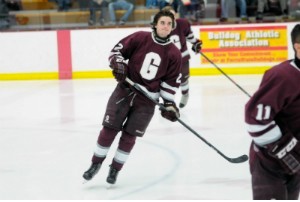
Now 17, Nate was 14 when she first took him to a doctor to find out why her son was in pain.
“Nate had an ache in his hip, and doctors took several sets of X-rays, even an MRI, but couldn’t find the source of his pain,” she said. “They diagnosed groin strains, bursitis, tendonitis, even arthritis, and no one seemed to question why someone so young would have arthritis.”
Nate Cekander wanted nothing more than to stay in the game. An avid hockey player at Grandville High School, he is passionate about his sport. Being a young athlete, however, he felt the pressure not to complain about any aches and pains.
“The hardest part for Nate was this unspoken assumption that he was making it up,” his mom said. “He perceived this sentiment from his own dad, an uncle who played hockey at one time, and his coach. Even his therapist told me, ‘Hockey is going to hurt.’”
Time and again, Nate was sent to physical therapy.
“Therapy helped—for a while,” Nate said. “But then the pain always came back.”
Cekander wasn’t about to give up. Pain that endures that long, she knew, wasn’t to be ignored. She took her son to pediatrician Stephen McMahon, MD. To her relief, he agreed that arthritis in someone so young was unlikely. He made a call to schedule an appointment for Nate with Olusanjo Adeoye, MD, an orthopaedic surgeon with Spectrum Health Medical Group.
Dr. Adeoye came to Spectrum Health in 2013, specializing in sports medicine and arthroscopic surgery, the only board-certified orthopaedic surgeon in West Michigan fellowship-trained in both hip arthroscopy and hip preservation.
He completed a fellowship at Stanford University as team physician for the University’s football and athletic program as well as the NFL’s San Francisco 49ers. Dr. Adeoye completed a second fellowship at Hospital for Special Surgery in New York, the nation’s leading orthopaedic and hip preservation program, where he focused on treating young people and athletes with hip, knee and shoulder injuries.
“I was able to diagnose Nate with a femoroacetabular impingement and a hip labral tear,” Dr. Adeoye said. “It was fairly obvious to me what was wrong when I ordered specialized X-rays that show more detail, then confirmed it with an MRI.”
A hip labral tear indicates a tear in the ring of cartilage, called the labrum, which lines the hip joint socket. The labrum operates as a kind of rubber seal to help hold the ball at the top of the thigh bone securely within the hip socket. It is most commonly seen in athletes in hockey, football, soccer and ballet.
“I was relieved to finally get a solution to my problem,” Nate admitted. “It was validating.”
Dr. Adeoye scheduled Nate for hip arthroscopy, a procedure that involves inserting a tiny camera into the hip joint through a small incision to identify the source of pain and then repair it. With this procedure, torn cartilage can be smoothed out or repaired, abnormal and inflamed tissue removed. The procedure is followed by about three to four months of physical therapy.
Ready, even eager for his surgery, Nate still had one special request of his surgeon.
“Before Nate’s surgery, Dr. Adeoye helped him get back in the game by referring him to one of his colleagues for a steroid injection in his hip,” Cekander said. “This allowed Nate to finish his junior year hockey season instead of watching from the bench. His team made it to the hockey state semi-final round. On the day of the semi-final game, March 7, 2014, his co-captain Ryan Fischer died of an enlarged heart. The team opted to play in his honor. For Nate, being able to play in this game to honor Ryan instead of watching the game from the sidelines was huge.”
Having paid his respects to his teammate, Nate was then ready for surgery.
The surgery took about two-and-a-half hours. Nate was able to go home the same day, wearing a hip brace and using crutches.
Nate remembers little after his surgery, but his mom smiles at the memory.
“He was still heavily sedated, but even in that state, his first request was to ask for his doctor,” she said. “I asked him why, was he in pain? He said no, he just wanted to thank him.”
“I think it’s crazy that I could do more four months after surgery than I could over the three years before,” Nate said.
His mom added: “This surgery and recovery isn’t just about hockey, but about quality of life. We are profoundly grateful to Dr. Adeoye and his team, including his physical therapist, Corey Snyder. It is impossible to express in words what they have done for him.”
 /a>
/a>
 /a>
/a>
 /a>
/a>